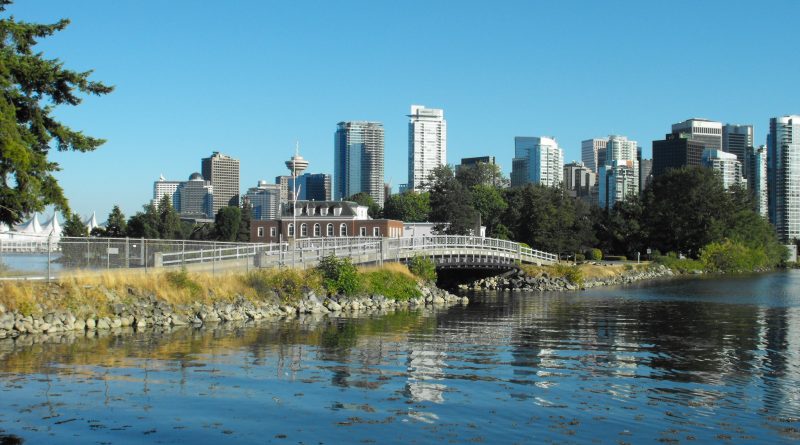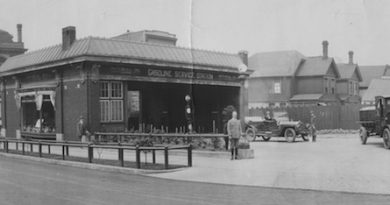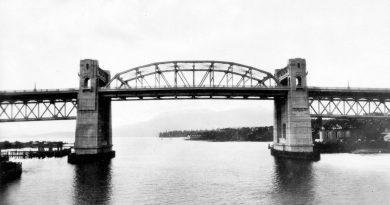HMCS Discovery
About 20 members of the Vancouver Historical Society enjoyed a treat recently with a visit to HMCS Discovery, the Canadian Naval Reserve base on Deadman’s Island in Stanley Park. For many of us, even a few born here, it was our first entry onto the island.
The tour was conducted by Lt. Jack Wyne, a reserve officer who joined back in 1986 and, except for a gap between 1994 and 1998, has been serving here since. (In civilian life, he has worked many years for a big brewing company here.)
We learned that of the 24 Naval Reserve Units across Canada, Discovery is arguably the most beautiful owing to its unique location and setting. It is also the oldest original location, having been established on the island in 1943. The base was named probably for Capt. George Vancouver’s ship, but there are some who claim it was named after Capt. Robert Scott’s Antarctic exploration vessel—moored to this day in the Thames in London.
Because the base is land-locked and not an actual sea-going ship it (and others like it) is by Naval tradition called a “stone frigate.” Therefore her crew refer to Discovery as a ship. There are generally from 150 to 250 people serving aboard her, down somewhat from the days of the Second World War when more than 1,000 could be found on the island. The island was a busy place after the war, too, because most of the veterans from BC were “demobbed” at Discovery. There’s a small naval museum here.

Reservists gather here on three Tuesdays and one Saturday a month, and officers, non-commissioned officers and specialists also meet on Thursdays for “administrative nights”. Many reservists are students of university age and take advantage of the majority of trades training, which is done in the summer. They train as signalmen, diesel operators, bosuns and the like. (Lt. Wyne’s training is in Naval Control of Shipping, but he’s soon to shift to intelligence work.) Sea Cadets and Naval Cadets meet and train here, too, and the base has even been a movie location. Arnold Schwarzenegger filmed some of The 6th Day here, and was so pleased with his reception he donated a big barbecue set-up to Discovery. It was, alas, inactive during our tour. Some episodes of the TV series Danger Bay and MacGyver were shot here.
As our group strolled along the Discovery‘s jetty, a stone’s throw across the water from the Royal Vancouver Yacht Club’s berths, a Harbor Air seaplane roared in overhead. At the end of the jetty, a few small craft of the Canadian Forces Sailing Assn. bobbed in the saltchuck. We learned that a few Vancouver Police Department and RCMP officers are CFSA members.

Lt. Wyne took us through several buildings on the base, where we were shown messes (dining rooms) for various ranks, each with a wealth of naval memorabilia on the walls: paintings, crests from visiting ships, superb ship models, photographs, vintage uniforms and a fine mural on naval history painted in 1945 by Robert S. Alexander and situated just above the entrance to the Wardroom (the Officers’ Mess). There’s a big photograph showing HMCS Skeena carrying King George VI and Queen Elizabeth (the Queen Mother) to Victoria in June, 1939. The wardroom houses a real historic treasure: the battle ensign of HMT Strathelliot, one of the great flotilla that helped during the evacuation of Dunkirk, May 26 to June 4, 1940. (HMT stands for His Majesty’s Trawler.) The flag, weather-beaten and faded, was donated by Jack Bryden in February, 1965.
Discovery is also home to the Vancouver Naval Veterans’ Association.
Curiously, because of the shallow depth of the water around the base, no deep sea vessels can moor there. To board any sizeable naval craft, reservists must go to the north shore or, more often, to Esquimalt.
There is a book on the history of the base, published in the mid-1990s and written by Commissioned Officer Barbara Winters. Its title (what else?): H.M.C.S Discovery.
A final word: we discovered, thanks to Lt. Wyne, that the Discovery‘s crest is a “rebus,” a visual pun. It was designed by Robert Watt, Chief Herald of Canada. Note the disc over the letter “Y,” hence: Disc-over-Y.




![Fountain Chapel Picnic, 1935 [Photo credit: Gibson Family]](https://vancouverhistory.ca/wp-content/uploads/2021/02/community-390x205.jpg)